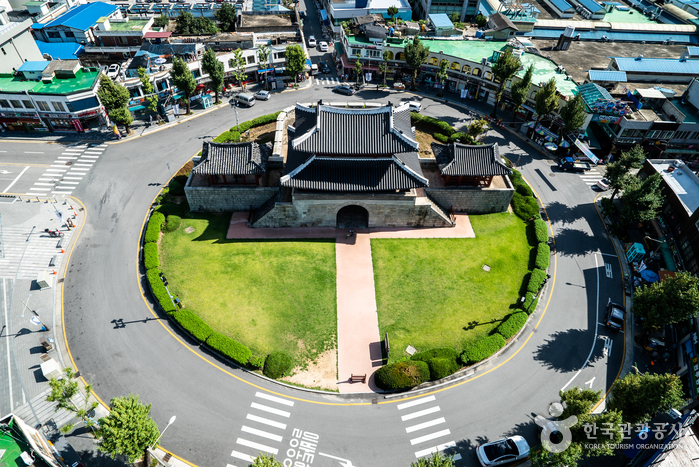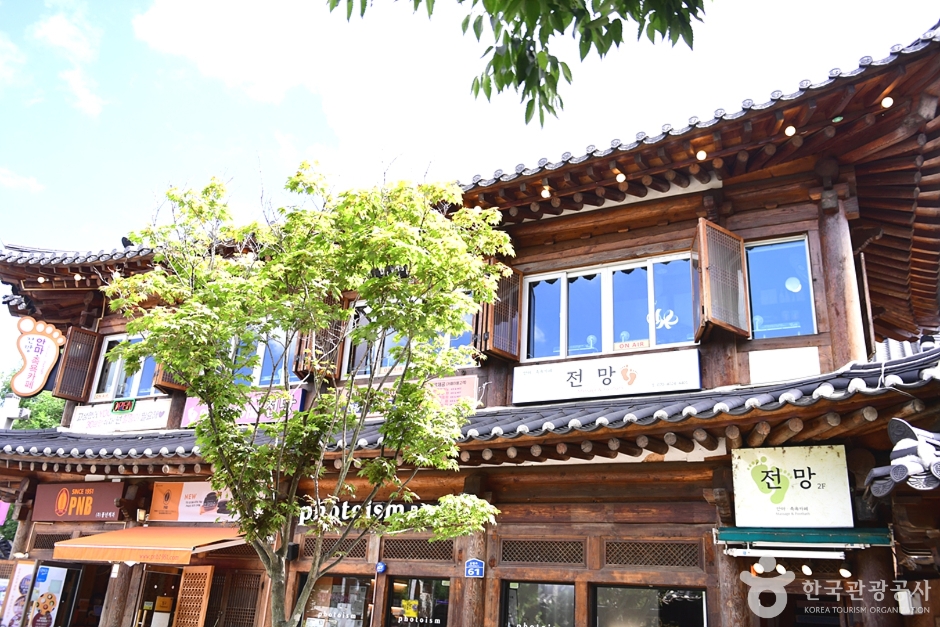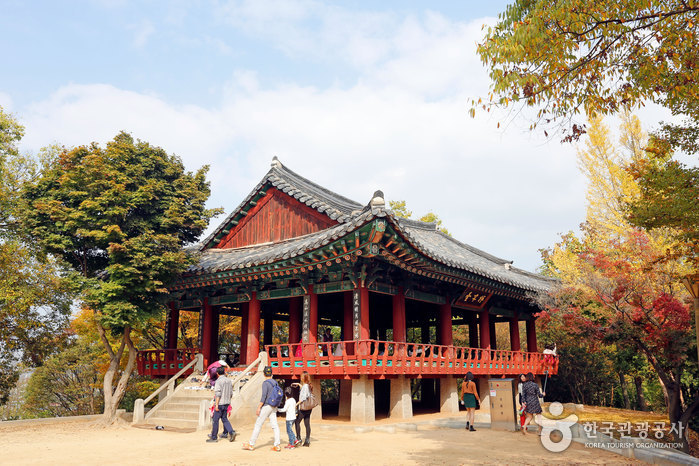Jeonju Pungnammun Gate (전주 풍남문)
798.989564468317m 29322 2024-05-27
1 Pungnammun 3-gil, Wansan-gu, Jeonju-si, Jeonbuk-do
+82-63-287-6008
Pungnammun Gate was built during the Joseon dynasty in 1734 and is a designated Treasure. Pungnammun Gate was the southernmost gate among the four city gates of Jeonju. The structure was severely damaged by fire in 1767, followed by the restoration of the gate tower afterward. The gate was burnt down once again during the Imjin War and was restored to the gate that is seen today.
Jeonggahanog [Korea Quality] / 정가한옥 [한국관광 품질인증]
805.6209178920216m 177 2024-04-07
78-3 , Girin-daero, Wansan-gu, Jeonju-si, Jeonbuk-do
+82-10-9934-1300, +82-10-3677-1928
Jeongga Hanok, standing right across the road from Jeonju Hanok Village, Jeollabuk-do, is a newbuild hanok combining traditional style with modern comfort. Guestrooms are cypress-walled and red clay-grounded. Thus the Cypress room has walls and ceilings of cypress wood. The Maple room and the Gingko room both have attics. Nearby tourist attractions, which can all be reached on foot, include Gyeonggijeon Hall, Jeondong Cathedral, Jeonju Hyanggyo Confucian School, Jaman Mural Village - and of course Jeonju Hanok Village.
Jeonmang Foot Bath Café (안마 족욕 카페 전망)
811.9453405863651m 0 2024-04-07
61 Eunhaeng-ro, Wansan-gu, Jeonju-si, Jeonbuk-do
Jeonmang Foot Bath Café is located inside Jeonju Hanok Village. Visitors can enjoy aromatic foot baths to relieve the fatigue from traveling while enjoying the view of the quaint hanok village. There are a variety of bath bombs, such as aroma, peppermint, and rosemary. The foot bath and shoulder massage come with a free drink and take about 40 minutes.
Ducksugung[Korea Quality] / 전주 한옥마을 덕수궁[한국관광 품질인증]
831.3501270059487m 1 2024-04-07
10 , Gannap-ro, Wansan-gu, Jeonju-si, Jeonbuk-do
+82-10-2625-4336
Deoksugung is a traditional hanok stay situated in a residential area across from the entrance to Jeonju Hanok Village. It has seven rooms for couples and one room for four people, all of which are ondol rooms. Rooms are equipped with a bathroom, a mini-refrigerator, television, and a private parking lot. There is no cooking allowed in the rooms, but you are welcome to prepare simple meals in the shared kitchen. Rentals of hanboks and rail bikes are available at a discount at the hotel.
Jeonju Jeondong Catholic Cathedral (전주전동성당)
847.6823513240889m 52001 2024-05-27
51 Taejo-ro, Wansan-gu, Jeonju-si, Jeonbuk-do
Jeondong Catholic Cathedral in Jeonju was built in honor of Roman Catholic martyrs of the Joseon dynasty on the very same spot the martyrs lost their lives. The land was purchased by French Priest Baudenet in 1891 (28th year of King Gojong), but construction of the church did not begin until 1908. Construction was completed in 1914, a time during which Korea was under Japanese rule. Though originally built just outside of Pungnammun Gate, the site of the martyrs, the church was later moved to its current location for expansion.
The first Romanesque building in the Honam region, Jeondong Catholic Cathedral is made of gray and red bricks and bears a striking resemblance to the Myeongdong Cathedral in Seoul, also designed by Priest Poinel. Not only considered one of the most beautiful Catholic churches in Korea, some even go so far as to say it is one of the most beautiful structures in all of Korea, citing the church’s unique combination of Byzantine and Romanesque architectural styles. The rectangular building is topped with three Byzantine bell towers (to the right, center, and left) and boasts arched ceilings, several of which meet in the form of a cross.
It is interesting to note that some of the bricks used in construction of the church were made using materials from the Jeonjueupseong Walled Town, which was torn down by the Japanese. It is also said that the cornerstone of the church came from a wall of Jeonjueupseong Walled Town near Pungnammun Gate.
Jeonju Handicraft Exhibition Hall - Jeonju Hanok Village Branch [Tax Refund Shop] (전주공예품전시관 전주한옥마을)
867.9323169148962m 1 2024-04-19
15, Taejo-ro, Wansan-gu, Jeonju-si, Jeollabuk-do
-
The Hanok [Korea Quality] / 더 한옥 [한국관광 품질인증]The Hanok [Korea Quality] / 더 한옥 [한국관광 품질인증]
884.0581271569067m 875 2024-04-07
68-15 , Eunhaeng-ro, Wansan-gu, Jeonju-si, Jeonbuk-do
+82-10-2189-4002
The Hanok, located in Jeonju, Jeollabuk-do, is a large hanok guesthouse built of beautiful tradition materials - cypress wood, red clay, and traditional hanji paper. The largest of the 7 rooms (Gwibin - ‘Special Guest’) has a king-size bed, ondol underfloor heating, and a massage bed, making it suitable for two families. One room has an attic, one has an red clay bed, and one has a bunk bed made of re-used traditional materials. In the spacious yard, guests can enjoy delightful moonlight tea parties.
Yeohangga [Korea Quality] / 여행가 [한국관광 품질인증]
907.4898394454978m 9718 2024-04-07
74-11 , Eunhaeng-ro, Wansan-gu, Jeonju-si, Jeonbuk-do
+82-63-231-3040, +82-10-7742-6738
The Traveler, located in Jeonju, Jeollabuk-do, is a pleasant place to stay for families in particular. Apart from the charm of staying in a hanok, visitors can experience traditional games of chance like the Twelve Bridges Game and the Pumpkin Wheel Game. Each room is equipped with a bathroom/toilet, and residents can use the kitchen in the main house to prepare meals.
Damun (다문)
908.9657497622857m 8128 2024-04-07
74-8, Eunhaeng-ro, Wansan-gu, Jeonju-si, Jeonbuk-do
+82-63-288-8607
Situated in Jeonju Hanok Village, Gyo-dong, Jeonju-si, Damun serves Korean table d’hote in a restaurant divided into large and small rooms within a hanok building structure.
Omokdae and Imokdae Historic Sites (오목대와 이목대)
924.5525271327285m 27949 2024-04-07
55 Girin-daero, Wansan-gu, Jeonju-si, Jeonbuk-do
+82-63-281-2114
Omokdae Historic Site is located on top of a steep hill and is one of the places where Yi Seong-gye, who later became King Taejo, the first king of the Joseon dynasty, stopped to celebrate his victory on his way home from a war against the Japanese army at Unbong Peak of Hwangsan Mountain. Across the bridge from Omokdae is Imokdae Historic Site, situated at the foot of Seungamsan Mountain. Approximately 80 meters downhill from Imokdae are memorial stones and a building where Mokjo, the great-great-grandfather of King Taejo, once used to live. The engraved letters on the stones are the handwritings of Emperor Gojong. Mokjo moved to Hamgyeongdo as a result of a dispute with the then minister of Jeonju, an incident which King Taejo believed to have laid the foundation for him to shape the Joseon dynasty.

![Jeonggahanog [Korea Quality] / 정가한옥 [한국관광 품질인증]](http://tong.visitkorea.or.kr/cms/resource/62/2594362_image2_1.jpg)

![Ducksugung[Korea Quality] / 전주 한옥마을 덕수궁[한국관광 품질인증]](http://tong.visitkorea.or.kr/cms/resource/01/2813401_image2_1.jpg)


![The Hanok [Korea Quality] / 더 한옥 [한국관광 품질인증]The Hanok [Korea Quality] / 더 한옥 [한국관광 품질인증]](http://tong.visitkorea.or.kr/cms/resource/68/2556468_image2_1.jpg)
![Yeohangga [Korea Quality] / 여행가 [한국관광 품질인증]](http://tong.visitkorea.or.kr/cms/resource/63/2572563_image2_1.jpg)


 English
English
 한국어
한국어 日本語
日本語 中文(简体)
中文(简体) Deutsch
Deutsch Français
Français Español
Español Русский
Русский